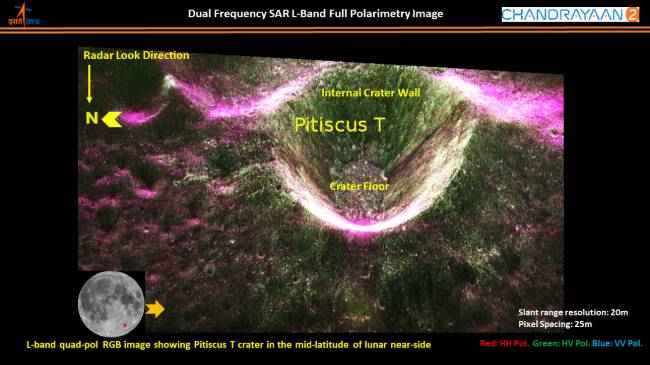ISRO has recently published images of the lunar surface taken through the Chandrayaan-2 orbiter on its official Twitter account. The most recent image, posted on Twitter on October 22, shows the Moon's rocky face filled with craters. ISRO is currently studying the south polar region of the moon, where we find numerous permanently shadowed regions filled with water ice. To capture these images, ISRO has used the orbiter's dual-frequency synthetic aperture radar (DF-SAR).
In ISRO's most recent tweet, we see a polarised image of the lunar south pole region. In it we can see numerous craters in the region, both big and small, young and old. We can also see the highlighted rims around some craters along with the surrounding ejecta material in dim yellow. Ejecta, in planetary geology, refers to the debris ejected during the formation of impact craters. When observed as an asymmetrical spread around a crater on the moon, it's often called an ejecta blanket.

While some craters have been formed as the result of a vertical impact, others have been formed as the result of an oblique impact. ISRO has highlighted this difference in its image. In another image, ISRO has zoomed in on the inner wall of crater Pitiscus T, which is located in the mid-latitude of the lunar near-side (farther away from the south pole). To capture these images, ISRO has operated the DF-SAR unit aboard the orbiter in full-polarimetry mode, which, it claims, is the gold standard in SAR polarimetry.
ISRO launched Chandrayaan-2 from the Satish Dhawan Space Centre in Sriharikota on July 22. While the lunar orbiter separation happened successfully in early September, the lander unit (Vikram) encountered a communications error with Earth minutes before its touchdown on the lunar surface. Though there have been recent search attempts to locate the lander—with help from NASA's Lunar Reconnaissance Orbiter (LRO) as well—all the evidence points to a hard landing or fatal crash. Vikram's remains are believed to be hidden in a shadowed part of the moon.
#ISRO#Chandrayaan2’s DF-SAR is designed to produce greater details about the morphology and ejecta materials of impact craters on the lunar surface. Have a look of initial images and observations made by DF-SAR For more details please visit: https://t.co/1j7SBcXIpl pic.twitter.com/SEHukoYJMV
— ISRO (@isro) October 22, 2019
from Latest Technology News https://ift.tt/2MKCNRZ

No comments:
Post a Comment